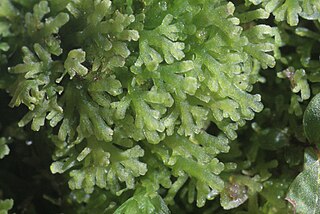Related Research Articles

Metzgeriales is an order of liverworts. The group is sometimes called the simple thalloid liverworts: "thalloid" because the members lack structures resembling stems or leaves, and "simple" because their tissues are thin and relatively undifferentiated. All species in the order have a small gametophyte stage and a smaller, relatively short-lived, spore-bearing stage. Although these plants are almost entirely restricted to regions with high humidity or readily available moisture, the group as a whole is widely distributed, and occurs on every continent except Antarctica.

Jungermanniaceae is the namesake family of leafy liverworts. It is a group of small plants that are widely distributed. Several genera formerly included within the family are now classified in the Myliaceae or Solenostomataceae.

Jungermanniopsida is the largest of three classes within the division Marchantiophyta (liverworts).

Lepidoziaceae is a family of leafy liverworts. It is a group of small plants that are widely distributed.

Aneuraceae is a family of thallose liverworts in the order Metzgeriales. Most species are very small with narrow, branching thalli.

Blasiales is an order of liverworts with a single living family and two species. The order has traditionally been classified among the Metzgeriales, but molecular cladistics suggests a placement at the base of the Marchantiopsida.
Aneura mirabilis is a species of liverworts in the family Aneuraceae. It was first described in 1933, as Cryptothallus mirabilis. Plants of this species are white as a result of lacking chlorophyll, and their plastids do not differentiate into chloroplasts.

Pleurozia is the only genus of liverworts in the family Pleuroziaceae, which is now classified in its own order Pleuroziales, but was previously included in a broader circumscription of the Jungermanniales. The genus includes twelve species, and as a whole is both physically distinctive and widely distributed.

Solenostomataceae is a family of liverworts in the order Jungermanniales.

Lophoziaceae is a family of liverworts belonging to the order Jungermanniales.

Acrobolbaceae is liverwort family in the order Jungermanniales.

Gymnomitriaceae is a liverwort family in the order Jungermanniales.

Cephaloziaceae is a family of liverworts.

Calypogeiaceae is a family of liverworts. This type of plant is a calcifuge.

Aneura is a genus of liverworts in the family Aneuraceae.
Anastrophyllaceae is a family of liverworts belonging to the order Jungermanniales.
Balantiopsidaceae is a family of liverworts belonging to the order Jungermanniales.

Cephaloziellaceae is a family of liverworts belonging to the order Jungermanniales.
Cleveaceae is a family of liverworts belonging to the order Marchantiales.
Lepidolaenaceae is a family of liverworts belonging to the order Porellales.
References
- ↑ Crum, Howard; James Bruce (1996). "A new species of Cryptothallus from Costa Rica". The Bryologist. 99 (4): 433–438. doi:10.2307/3244107. JSTOR 3244107.
- ↑ Renzaglia, Karen S. (1982). A comparative developmental investigation of the gametophyte generation in the Metzgeriales (Hepatophyta). Bryophytorum Bibliotheca. Vol. 24. Vaduz: J. Cramer.
- ↑ Wickett, N. J.; B. Goffinet (2008). "Origin and relationships of the myco-heterotrophic liverwort Cryptothallus mirabilis Malmb. (Metzgeriales, Marchantiophyta)". Botanical Journal of the Linnean Society. 156 (1): 1–12. doi: 10.1111/j.1095-8339.2007.00743.x .
- ↑ Preussing, M.; Olsson, S.; Schäfer-Verwimp, A.; Wickett, N.J.; Wicke, S.; Quandt, D. & Nebel, M. (2010). "New insights in the evolution of the liverwort family Aneuraceae (Metzgeriales, Marchantiophyta), with emphasis on the genus Lobatiriccardia". Taxon. 59 (5): 1424–1440. doi:10.1002/tax.595009.
- 1 2 Söderström, Lars; Hagborg, Anders; von Konrat, Matt; Bartholomew-Began, Sharon; Bell, David; Briscoe, Laura; Brown, Elizabeth; Cargill, D. Christine; da Costa, Denise Pinheiro; Crandall-Stotler, Barbara J.; Cooper, Endymion; Dauphin, Gregorio; Engel, John; Feldberg, Kathrin; Glenny, David; Gradstein, S. Robbert; He, Xiaolan; Hentschel, Joern; Ilkiu-Borges, Anna Luiza; Katagiri, Tomoyuki; Konstantinova, Nadezhda A.; Larraín, Juan; Long, David; Nebel, Martin; Pócs, Tamás; Puche, Felisa; Reiner-Drehwald, Elena; Renner, Matt; Sass-Gyarmati, Andrea; Schäfer-Verwimp, Alfons; Segarra-Moragues, José; Stotler, Raymond E.; Sukkharak, Phiangphak; Thiers, Barbara; Uribe, Jaime; Váňa, Jiří; Wigginton, Martin; Zhang, Li; Zhu, Rui-Liang (2016). "World checklist of hornworts and liverworts". PhytoKeys (59): 1–828. doi:10.3897/phytokeys.59.6261. ISSN 1314-2003. PMC 4758082 . PMID 26929706.